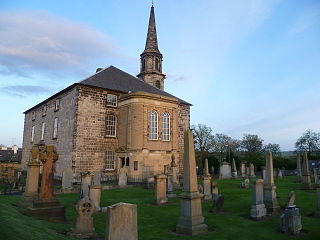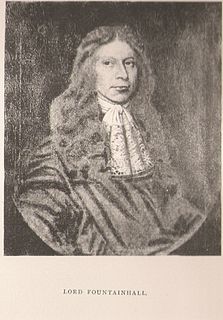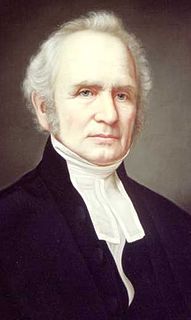George Gordon, 1st Earl of Aberdeen, was a Lord Chancellor of Scotland.

Sir Joseph Fayrer, 1st Baronet FRS FRSE FRCS FRCP KCSI LLD was an English physician noted for his writings on medicine, particularly the treatment of snakebite, in India.

Inveresk is a village in East Lothian, Scotland situated immediately to the south of Musselburgh. It has been designated a conservation area since 1969. It is situated on slightly elevated ground on the north bank of a loop of the River Esk. This ridge of ground, 20 to 25 metres above sea level, was used by the Romans as the location for a fort in the 2nd century AD.

The Grange is a suburb of Edinburgh, about one and a half miles south of the city centre, with Morningside and Greenhill to the west, Newington to the east, and Marchmont to the north. It is a conservation area characterised by large late Victorian stone-built villas, often with very large gardens. Many have now been sub-divided into flats, with further flats often being built on the grounds.
Cumberland is a former United Kingdom Parliamentary constituency. It was a constituency of the House of Commons of the Parliament of England then of the Parliament of Great Britain from 1707 to 1800 and of the Parliament of the United Kingdom from 1801 to 1832. It was represented by two Knights of the Shire. It was divided between the constituencies of Cumberland East and Cumberland West in 1832.
There has been one baronetcy granted to the Lauder family. The baronetcy of Lauder of Fountainhall, Haddingtonshire, was created for John Lauder, last surviving male representative of the Lauders of that Ilk, a rich merchant-burgess and sometime Treasurer and baillie of the City of Edinburgh, and an armiger. He purchased the estate of Newington, Edinburgh, and subsequently the lands of Woodhead and Templehall near Pencaitland, which along with others in Edinburghshire and Haddingtonshire, were erected by Crown charter into the feudal barony of Fountainhall on 13 August 1681.

Sir John Lauder, 1st Baronet, of Newington and Fountainhall was a notable Scottish baillie and Treasurer of the City of Edinburgh, who was raised to a Nova Scotia baronetcy in 1688.
Sir Andrew Lauder of Fountainhall, 5th Baronet was a Burgess of the Royal Burgh of Lauder, and also of Musselburgh.
Sir Alexander Lauder of Fountainhall, 4th Baronet succeeded to the baronetcy of his father, Sir John Lauder, 3rd Baronet in February 1728. He was made an Honorary Burgess of the City of Glasgow on 16 September of that year, and of the burgh of Aberdeen on 15 August 1729. He died unmarried and was interred in the Lauder burial vault within Greyfriars Kirk.
Sir John Lauder of Fountainhall, 3rd Baronet was born 3 and baptised 5 December 1669 at Greyfriars Kirk, Edinburgh, Midlothian, Scotland. He died in February 1728 at Fountainhall manor, near Pencaitland, and was interred in the Lauder burial vault within Greyfriars. He succeeded his father John Lauder, Lord Fountainhall in the baronetcy in September 1722.

Sir John Lauder of Fountainhall, 2nd Baronet, Lord Fountainhall was one of Scotland's leading jurists who remains to this day an oft consulted authority. He was knighted in 1680 and matriculated his Arms with the Lyon Court on 15 June 1699.
Sir Alexander Seton of Pitmedden, 1st Baronet, Lord Pitmedden was a Scottish advocate, a Senator of the College of Justice, a Lord of Justiciary, and a Commissioner.
The Broun Baronets are a branch of the ancient Broun of Colstoun family whose estate near Haddington, East Lothian, remains to this day in the possession of a cadet family.

There have been eleven baronetcies created for persons with the surname Robinson, four in the Baronetage of England, one in the Baronetage of Great Britain and six in the Baronetage of the United Kingdom. As of 2008 two of the creations are extant while one is dormant.

Sir Thomas Lauder Brunton, 1st Baronet, was a Scottish physician who is most-closely associated with the use of amyl nitrite to treat angina pectoris.

Sir Henry Northcote, 5th Baronet, of Hayne in the parish of Newton St Cyres near Crediton in Devon, later of Pynes in the parish of Upton Pynes, Devon, was a Member of Parliament for Exeter from 1735 until his death in 1743.
Brunton is a surname. Notable people with the surname include:
Lauder is a surname of Scottish origin. Notable people with the surname include:








